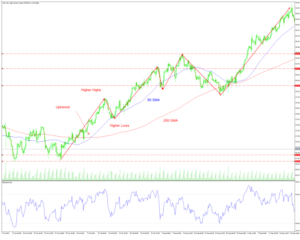In the world of global commodities, few hold as much sway as West Texas Intermediate (WTI) oil. Its price fluctuations reverberate through economies, influence energy investments, and even impact our daily lives. For beginner traders, understanding the key drivers behind WTI’s movements can be the difference between riding the waves of profit and getting swept away by the tide of loss.
More than just a barrel of fuel, WTI is a benchmark. Its price serves as a reference point for crude oil trade worldwide, impacting everything from gasoline prices at the pump to the profitability of energy companies. Investing in WTI, therefore, isn’t just about buying and selling a commodity; it’s about tapping into the pulse of the global energy market.
What is WTI Oil?
Before we dive deep, let’s get acquainted with WTO oil. The oil is extracted from shale formations in the American Southwest, is known for its light, sweet composition, making it ideal for refining into high-quality gasoline and diesel. This coveted quality grants WTI its “benchmark” status, meaning its price serves as a reference point for most global oil transactions.
So, what makes WTI tick?
Supply and Demand: Imagine you have a favorite toy that everyone wants. If there are only a few of them, and lots of people want to buy, the price goes up because it’s in high demand. On the other hand, if there are many toys available but not many people want them, the price goes down.
This is similar to oil – when more people want oil than there is available (high demand), the price goes up. When there’s too much oil and not enough buyers (high supply), the price goes down.
Geopolitical Turmoil: When there’s trouble in places that produce a lot of oil, like wars or political problems, it can mess up the process of getting oil to people who need it. This disturbance can make the price of oil go up.
Economic Health: When countries and businesses are doing well and making money, they need more oil for their activities. This high demand can make oil prices go up. But if people don’t have much money, they won’t buy as much, and the price of oil might go down.
Dollar Strength: When the U.S. dollar is strong, it takes more of other currencies to buy oil priced in dollars. This can make oil more expensive for countries using different currencies, and it might lead to lower demand and lower prices.
Now you know the factors that affect WTI oil price and can apply your knowledge when preparing for trading, here you can check out WTI oil price.
Strategies & Tips for Crude Oil Trading
Knowing these factors is just the first step. Aspiring traders need a toolbox of strategies to navigate the often-choppy waters of the oil market. Here are a few beginner-friendly tactics:
- Buy and Hold:
Picture yourself as a patient investor, sipping coffee while watching the oil prices climb slowly but surely. This approach involves buying oil futures or ETFs (think of them as baskets of oil stocks) and holding them for years, hoping for that steady upward trend. It’s like buying a comfy seat on the rollercoaster and enjoying the long, smooth ride. - Swing Trading:
Are you more of an adrenaline junkie? Then swing trading might be your jam. This involves hopping on and off the rollercoaster for shorter rides, maybe a few days or weeks. You use technical analysis, like fancy charts and indicators, to spot quick price swings and aim to profit from them. Think of it like riding the rollercoaster a few times, getting off before the big dips, and hopping back on for the next climb.

- Spread Trading:
This one’s for the thrill-seekers who like to play with fire (figuratively, of course!). You basically buy and sell oil contracts at different times, like riding two different rollercoaster cars at once. If one car dips, the other might rise, and you profit from the difference. It’s risky, but if you do it right, you can make serious cash, even if the overall market is going haywire. - Technical Analysis:
Think of this as your secret decoder ring for the oil market. It’s a set of tools, like the RSI indicator, that help you analyze past price patterns and predict future trends. It’s like having a map of the rollercoaster, knowing when the big drops come and where the hidden treasure might be.
Historical performance of WTI prices
History holds valuable lessons for traders. Studying past WTI price movements can reveal recurring patterns and cycles, helping to anticipate future trends.
Identifying the impact of major events like the 2008 financial crisis or the 2014 Arab Spring or Russia – Ukraine war 2022 can provide valuable insights into how geopolitical and economic factors influence price movements.
Remember, the oil market is a complex beast, and success requires continuous learning and adaptation and even then you will get surprised. Staying informed about WTI dynamics through news, reports, and expert analysis is crucial.
The world runs on oil, and understanding its price movements can empower you to navigate the global energy market with confidence. With the right knowledge, strategies, and a healthy dose of caution, you can transform the volatility of WTI into a valuable opportunity for growth.
So, strap in, keep your eyes on the horizon, and prepare to ride the waves of the black gold!


